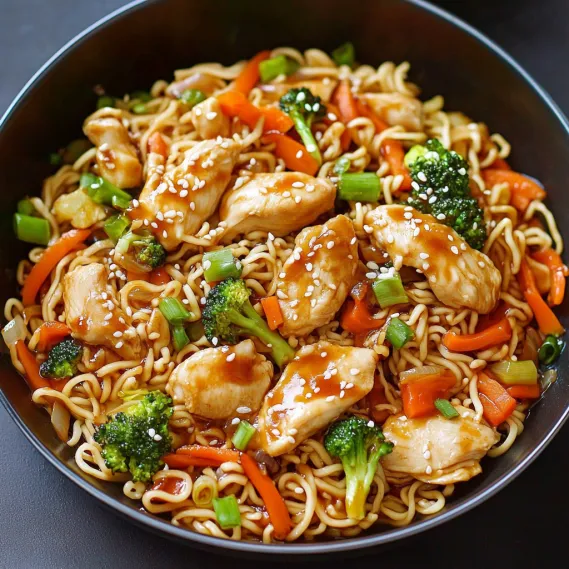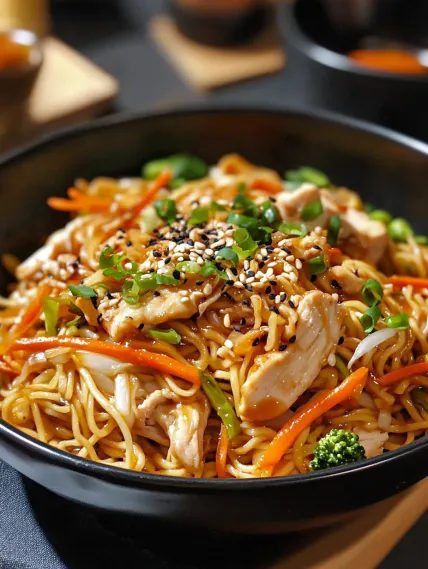 Pin it
Pin it
This hearty Chicken Yakisoba brings authentic Asian flavors right to your dinner table with minimal effort. The perfect balance of sweet, tangy and savory notes makes this stir-fried noodle dish an instant family pleaser that comes together in just 35 minutes.
I discovered this recipe during a busy weeknight when I needed something quick yet satisfying. After tasting authentic yakisoba during a trip to Japan, I was determined to recreate those flavors at home without specialized ingredients. This version has become our Thursday night tradition, with my kids requesting it specifically because they love twirling the noodles.
- Green cabbage: adds essential crunch and sweetness when cooked down
- Yellow onion: provides aromatic base that sweetens as it cooks
- Carrots: bring natural sweetness and beautiful color contrast
- Broccoli: adds nutritional value and soaks up the sauce beautifully
- Fresh ginger: essential for authentic flavor choose firm pieces with smooth skin
- Chicken breast: provides lean protein select antibiotic free if possible
- Vegetable oil: neutral base for cooking with high smoke point
- Sesame oil: gives authentic nutty flavor use toasted variety for best results
- Soy sauce: adds umami foundation choose low sodium if watching salt intake
- Worcestershire sauce: provides tangy depth surprisingly authentic for fusion cooking
- Ketchup: adds tomato sweetness and thickens the sauce
- Sriracha: brings gentle heat adjust according to preference
- Sugar: balances the salty savory elements choose brown sugar for deeper flavor
- Ramen noodles: perfect texture for stir fry buy fresh if available
How To Make Chicken Yakisoba
- Prep Ingredients:
- Start by organizing all components for quick assembly. Grate ginger using the fine side of your grater to release maximum flavor. Slice cabbage into thin strips about 1/4 inch wide. Cut chicken against the grain into pieces approximately 1/4 inch thick to ensure tenderness and quick cooking.
- Heat The Base:
- Heat your large skillet or wok until you can feel warmth hovering your hand 2 inches above the surface. Add vegetable oil and swirl to coat entire cooking surface. Add ginger immediately and stir constantly to prevent burning while it releases its aromatic oils approximately 45 seconds.
- Cook The Protein:
- Add chicken strips in a single layer if possible, allowing them to sear for 30 seconds before stirring. Continue cooking until no pink remains but avoid overcooking which would make the chicken tough. The chicken should have some golden edges but remain juicy inside.
- Add Vegetables:
- Introduce all vegetables to the hot skillet starting with onions followed by carrots, cabbage and finally broccoli. Keep everything moving constantly using tongs or two wooden spoons. The vegetables should soften but maintain some crispness with bright colors still visible.
- Prepare Noodles:
- Cook ramen just until they separate and become flexible but still have some firmness in the center, approximately 2 minutes rather than package directions. Rinse briefly under cold water to stop cooking then toss with a teaspoon of sesame oil to prevent sticking.
- Create Sauce:
- Whisk sauce ingredients in a bowl until sugar completely dissolves. The sauce should have a glossy appearance and smooth consistency. Taste and adjust if needed adding more sriracha for heat or a touch more sugar for sweetness.
- Combine Everything:
- Pour sauce around the perimeter of the hot pan rather than directly onto ingredients allowing it to sizzle and caramelize slightly. Add noodles and use tongs to lift and turn all ingredients ensuring every noodle gets coated with the savory sauce. Cook for 2 more minutes until everything is heated through and sauce thickens slightly.
 Pin it
Pin it
The ginger is truly the secret ingredient here. I discovered its importance after making this dish without it once when I ran out. The difference was remarkable. Fresh ginger provides that distinctive warmth and slight peppery note that elevates this dish from ordinary to restaurant quality. My grandmother always taught me that ginger is the bridge between savory and sweet elements in Asian cooking.
Storing Leftovers
Yakisoba stores beautifully in airtight containers in the refrigerator for up to 3 days. The flavors actually continue to develop overnight making this an excellent meal prep option. To reheat add a tablespoon of water before microwaving to restore moisture or quickly reheat in a skillet adding a splash of soy sauce to refresh the flavors. The noodles will absorb more sauce during storage which intensifies the flavor profile.
 Pin it
Pin it
Vegetable Variations
This recipe welcomes creativity with vegetables. Bell peppers add wonderful color and sweetness. Snow peas or sugar snap peas introduce textural contrast. Mushrooms particularly shiitake create umami richness. Bean sprouts added at the very end provide fresh crunch. In spring I love adding asparagus cut into 1inch pieces and in fall bok choy makes a wonderful addition. Remember to adjust cooking times based on the vegetables you choose adding firmer vegetables earlier and more delicate ones later.
Protein Alternatives
While chicken breast works beautifully in this recipe other proteins shine equally well. Thinly sliced beef particularly sirloin cooks quickly and adds rich flavor. Shrimp needs just 23 minutes and brings seafood sweetness. For vegetarian versions try firm tofu pressed and cubed or even a cup of edamame beans. Each protein variation brings its own character to the dish while maintaining the essential yakisoba experience.
Frequently Asked Questions
- → What vegetables work best in Chicken Yakisoba?
Crisp vegetables like cabbage, carrots, onions, and broccoli work wonderfully in Yakisoba. These add texture and freshness to the dish.
- → Can I use a different protein instead of chicken?
Absolutely! You can substitute chicken with shrimp, beef, tofu, or even pork for a different take on the dish.
- → What type of noodles should I use for Yakisoba?
Ramen noodles are a great option for Yakisoba. You can also use specific Yakisoba noodles or soba noodles for an authentic touch.
- → How can I make the sauce less spicy?
For a milder sauce, reduce or eliminate the sriracha. You can replace it with a sprinkle of sugar for additional sweetness.
- → How do I avoid soggy vegetables in Yakisoba?
Cook vegetables over medium-high heat and avoid overcooking. Stir-fry them quickly to maintain their crisp texture.
- → Can I prepare this dish ahead of time?
Yes, you can make the components (sauce, cooked noodles, and stir-fried vegetables) ahead of time and combine them just before serving.
